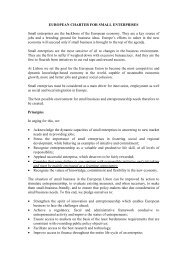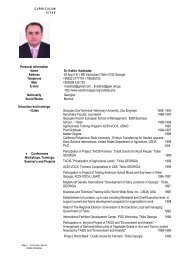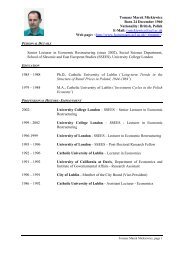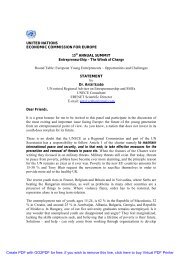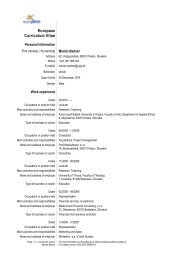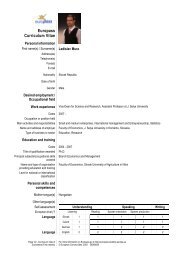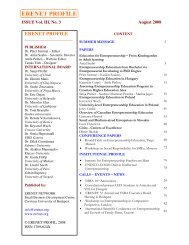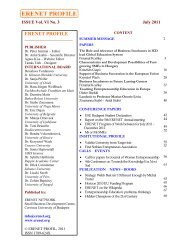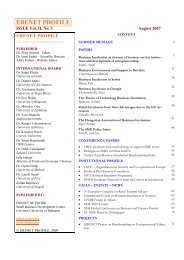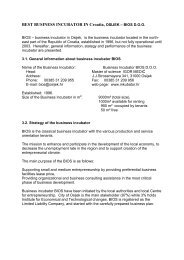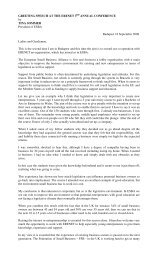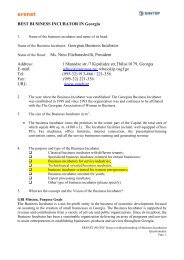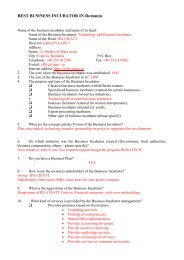are private pension funds, broker houses, as well as insurance companies <strong>and</strong> banks that areactively including into investment banking transactions.Start-up loans, provided by <strong>the</strong> <strong>Development</strong> Fund, are intended for self employment byestablishing h<strong>and</strong>crafts, manufactures or service enterprises. Start-ups are provided with Euro5,000 to Euro 15,000 loan, one-year pay <strong>of</strong>f period, one-year grace period, 1% interest rate onannual level <strong>and</strong> three-month pay <strong>of</strong>f. According to National Investment Plan, beginners will beprovided with Euro 7 million.3.4.6. TASKS FOR IMPROVEMENT AND FURTHER DEVELOPMENT OF <strong>SME</strong> SECTORSBy <strong>the</strong> number <strong>of</strong> entrepreneurs <strong>and</strong> small <strong>and</strong> medium enterprises, Serbia considerablydelays comparing with <strong>the</strong> o<strong>the</strong>r countries in <strong>the</strong> region. Because <strong>of</strong> that, <strong>the</strong> promotion <strong>of</strong>entrepreneurship <strong>and</strong> small <strong>and</strong> medium business is essential. The great chance could be <strong>the</strong>fur<strong>the</strong>r development <strong>of</strong> <strong>the</strong> business incubators, <strong>and</strong> technologic <strong>and</strong> industrial parks, wherelegal regulative <strong>and</strong> some very successful examples already exist. Also, <strong>the</strong> entrepreneursshould be acquainted with <strong>the</strong> importance <strong>of</strong> clustering <strong>and</strong> possibilities which this form <strong>of</strong>cooperation <strong>of</strong>fers. They also should be informed about <strong>the</strong> distribution <strong>of</strong> stimulating measuresfor cluster foundation. Lower costs, favorable credits, funds access are only some <strong>of</strong> <strong>the</strong>advantages that this form <strong>of</strong> cooperation <strong>of</strong>fers.Simultaneously, toge<strong>the</strong>r with promotional activities, <strong>the</strong> particular attention should bepaid on entrepreneurs’ education <strong>and</strong> to extend <strong>the</strong> knowledge <strong>and</strong> skills gamma necessary for<strong>the</strong> new circumstances. The higher level <strong>of</strong> knowledge <strong>and</strong> efficiency in <strong>SME</strong> is essential. Thelevel <strong>of</strong> knowledge <strong>and</strong> efficiency <strong>of</strong> entrepreneurs are far behind <strong>the</strong> real necessities. Thegreatest improvement in overcoming this state was realized by introduction <strong>of</strong> education forentrepreneurs in secondary schools in 2007/2008, but fur<strong>the</strong>r efforts in this field are veryimportant especially regarding <strong>the</strong> cooperation between <strong>the</strong> scientific institutions <strong>and</strong> economy.The relations between economy, education <strong>and</strong> scientific <strong>and</strong> research institutions should bedefined on completely new foundation.Fur<strong>the</strong>r investment in researches, development <strong>and</strong> improvement <strong>of</strong> technologicalequipment is needed.The lack <strong>of</strong> horizontal connection <strong>and</strong> establishing <strong>of</strong> cooperation among <strong>the</strong>organizations which <strong>of</strong>fer services to <strong>SME</strong> sector, such as Agency for <strong>SME</strong>, NationalEmployment Service, Chamber <strong>of</strong> Commerce, is obvious.It is important to extend <strong>the</strong> rank <strong>of</strong> <strong>the</strong> alternative financing sources. To developventure capital firms, private equity funds, business angels etc. Also, it is important to solve<strong>the</strong> question <strong>of</strong> micro-financing, which, for <strong>the</strong> time being, only exists within <strong>the</strong> bankingsector. The banking sector still has <strong>the</strong> monopoly on financial market. The specializedinstitutions for micro crediting should be founded.Measures directed to restrain <strong>the</strong> inflation <strong>and</strong> to create <strong>the</strong> less restrictive NationalBank’s credit <strong>and</strong> monetary policy, that would influence on reducing <strong>the</strong> interest rate on bankcreditsThe tax system is not adjusted to <strong>SME</strong>. Although <strong>the</strong> tax rate for enterprise pr<strong>of</strong>it <strong>of</strong>10% <strong>and</strong> VAT <strong>of</strong> 18% are among <strong>the</strong> lowest in Europe, <strong>the</strong>ir stimulating effects are devaluatedby ano<strong>the</strong>r burden with taxation, various fees, <strong>and</strong> administrative procedures. Modifications <strong>of</strong>certain legal regulative, especially in <strong>the</strong> field <strong>of</strong> fiscal legislative <strong>and</strong> fiscal collectionprocedure’s simplification.64
Number <strong>of</strong> measures promoting <strong>the</strong> competitiveness <strong>of</strong> Serbian enterprises which is, ingeneral, at very low level. At <strong>the</strong> same time, it is essential to make <strong>the</strong> structural economychanges comprising <strong>the</strong> greater orientation towards export adjusted production, in order tosolve <strong>the</strong> problem <strong>of</strong> payment balance <strong>and</strong> high foreign trade deficiency. CEFTA represents <strong>the</strong>great chance for all <strong>the</strong> region countries, comprising market extension for 9 states <strong>of</strong> WestBalkan.4. ACCELERATING SMALL BUSINESS DEVELOPMENT IN THE NEWLYINDEPENDENT STATES REGION: STRATEGIC APPROACH – EVIDENCEFROM MOLDOVA, RUSSIA AND UKRAINE 204.1 INTRODUCTION TO THE RESEARCHThe countries that have been involved in <strong>the</strong> Soviet orbit are currently restructuring<strong>the</strong>ir economies. The process <strong>of</strong> economic transition from a centrally planned to a marketbasedsystem takes enormous efforts <strong>and</strong> time for changing not only <strong>the</strong> economic situation in<strong>the</strong> country but mentality <strong>and</strong> even culture.Culture as a dynamic characteristic <strong>of</strong> <strong>the</strong> nation has some significant potential for change.Some nations possess <strong>the</strong> better potential for <strong>the</strong> change; <strong>the</strong> o<strong>the</strong>rs need longer time <strong>and</strong>stronger influence <strong>of</strong> catalyst factors.The mainstream <strong>of</strong> <strong>the</strong> research <strong>of</strong> <strong>the</strong> transition process is concentrated in severalareas: privatization; economy growth <strong>and</strong> its liberalization; institutional <strong>and</strong> legal reforms;socio-cultural consequences <strong>of</strong> <strong>the</strong> economic changes. The <strong>SME</strong> development is in <strong>the</strong> relationto all <strong>of</strong> <strong>the</strong>se issues, <strong>and</strong> even becomes crucial for <strong>the</strong> country’s economic success.The focus <strong>of</strong> this chapter <strong>of</strong> <strong>the</strong> paper will be on a catalyst factors providing <strong>the</strong> easiertransition to <strong>the</strong> market driven mentality in <strong>SME</strong> sector. We would make <strong>the</strong> generalcomparison <strong>of</strong> <strong>the</strong> pros <strong>and</strong> corns in <strong>the</strong> targeted countries’ <strong>SME</strong> developments from <strong>the</strong>st<strong>and</strong>point <strong>of</strong> strategic management principles, using general environment assessmentmethodology <strong>and</strong> Porter’s Diamond model <strong>of</strong> nations’ competitive advantage applied to <strong>SME</strong>sector, <strong>and</strong> five (+ complementary) forces approach (developed as an industry analysis, butwith <strong>the</strong> certain limitations, which we would describe later in this chapter, this tool could beused for <strong>the</strong> generalization <strong>of</strong> <strong>the</strong> <strong>SME</strong> problems in <strong>the</strong> transitioning countries).By <strong>the</strong> time <strong>the</strong> transition began, <strong>the</strong>re was a little knowledge <strong>and</strong> thus an experience <strong>of</strong>transformation from centrally planned economy to market driven in <strong>the</strong> region <strong>and</strong> even in <strong>the</strong>Glob. Nobody could advise or support <strong>the</strong> nations in <strong>the</strong>ir efforts for change. Therefore everynation went its own way even if <strong>the</strong>y started from <strong>the</strong> same or close points. Somest<strong>and</strong>ardization is helpful <strong>of</strong> course but should be carefully adjusted to <strong>the</strong> country’s cultural,political <strong>and</strong> current economic situation by policy makers. This statement has to be taken as abasic approach for <strong>the</strong> fur<strong>the</strong>r research <strong>and</strong> suggestions/recommendations for <strong>the</strong> <strong>SME</strong>development in <strong>the</strong> region.Theoretical arguments for <strong>the</strong> st<strong>and</strong>ardized recommendations for <strong>the</strong> <strong>SME</strong>development in <strong>the</strong> Black Sea RegionAccording to <strong>the</strong> Life Cycle Theory (A. Adizes, 1989) any organization has to passthrough several stages in its lifecycle. The state, as <strong>the</strong> specific form <strong>of</strong> organization, at <strong>the</strong>20 Prepared by Dr. Irina NAOUMOVA, Associated Pr<strong>of</strong>essor, Management Department <strong>and</strong> Member <strong>of</strong> <strong>the</strong> StrategicCommission for <strong>the</strong> Russian Federal Program <strong>of</strong> Retraining Managers, <strong>and</strong> College <strong>of</strong> Business Administration, UTK,Management Center, Knoxville, USA65
- Page 4 and 5:
1. SME DECLARATION AND WORKING GROU
- Page 6 and 7:
While comparing the BSEC and EU doc
- Page 8 and 9:
cooperation with the United Nations
- Page 10 and 11:
GENERAL ASSESSMENT OF THE BSEC WG O
- Page 12 and 13:
“Armenia's new law introduces a n
- Page 14 and 15: (iii)Share of the labor force of SM
- Page 16 and 17: The following data represents some
- Page 18 and 19: RankDocuments for export(number)Tra
- Page 20 and 21: • Industrial zones/Business incub
- Page 22 and 23: 3.1.4. FINANCING SMEsProf. Dr. Sela
- Page 24 and 25: • the loan is secured with movabl
- Page 26 and 27: 3.1.4.3. Mutual and loan guarantee
- Page 28 and 29: introduction of e-signatures, only
- Page 30 and 31: The Code of Conduct for Civil Serva
- Page 32 and 33: Trading Across Borders Enforcing Co
- Page 34 and 35: as with all non-governmental organi
- Page 36 and 37: Bulgarian SMEs obtain additional ca
- Page 38 and 39: • Project BG 2004/016-711.11.04 -
- Page 40 and 41: usiness is not approaching them oft
- Page 42 and 43: • Romanian citizens are recognize
- Page 44 and 45: The preparatory project of the NDP
- Page 46 and 47: • To support participation in eco
- Page 48 and 49: In 2004, the National Institute of
- Page 50 and 51: Incubators host on average 11 SME,
- Page 52 and 53: Programs. The program is implemente
- Page 54 and 55: development instrument is extremely
- Page 56 and 57: accounting standards, including med
- Page 58 and 59: corporations and open held corporat
- Page 60 and 61: promoting SME sector, cooperation w
- Page 62 and 63: • for unemployed (micro credit)
- Page 66 and 67: very early steps of its democratic
- Page 68 and 69: Another negative factor that is mor
- Page 70 and 71: economy. The so called in the organ
- Page 72 and 73: Federal funds, private capital, esp
- Page 74 and 75: 4.3. MOLDOVATable 14.Dimensions Neg
- Page 76 and 77: Related andsupportingindustriesDome
- Page 78 and 79: Technological:Internetaccessibility
- Page 80 and 81: Domesticdemand• Still not many pe
- Page 82 and 83: international investments• Govern
- Page 84 and 85: 3. Hamel, G., Prahalad, C.K. (1994)
- Page 86 and 87: 5.2 DEVELOPMENT OF THE SME SECTOR I
- Page 88 and 89: General Characteristic of SME Devel
- Page 90 and 91: Index of SME Development in Armenia
- Page 92 and 93: The same problem exists in getting
- Page 94 and 95: SME support infrastructure in Armen
- Page 96 and 97: 5 million was provided by UNDP and
- Page 98 and 99: 5.3 DEVELOPMENT OF THE SME SECTOR I
- Page 100 and 101: Diagram 1. The number of small ente
- Page 102 and 103: The privatization process of object
- Page 104 and 105: 13.Cabinet Provision on “Distribu
- Page 106 and 107: 5.3.3. SME support infrastructure i
- Page 108 and 109: The role of the state in technical
- Page 110 and 111: General situation of credit marketT
- Page 112 and 113: After creation and starting impleme
- Page 114 and 115:
At the meantime, small enterprise s
- Page 116 and 117:
Table. 32.Ease of businessDoingBusi
- Page 118 and 119:
people who start small businesses t
- Page 120 and 121:
are salaried and the medium - sized
- Page 122 and 123:
Technology Foresight in Greece 2001
- Page 124 and 125:
Greek VC market started to develop
- Page 126 and 127:
In the area of bankruptcy and restr
- Page 128 and 129:
enterprises. According to TURKSTAT,
- Page 130 and 131:
small size enterprise or micro ente
- Page 132 and 133:
industrial enterprises. Undersecret
- Page 134 and 135:
individuals, rather than well struc
- Page 136 and 137:
7. SUGGESTIONS FOR THE SME DEVELOPM
- Page 138 and 139:
Annex 1.MAP OF THE BLACK SEA COUNTR
- Page 140 and 141:
17-18 June 2005 1 st Moscow Interna
- Page 142 and 143:
ARMENIASTRENGTHS• Application of
- Page 144 and 145:
BULGARIASTRENGHT• Flexibility and
- Page 146 and 147:
GREECESTRENGHT• They have a vital
- Page 148 and 149:
ROMANIASTRENGHTWEAKNESS• Stabilis
- Page 150 and 151:
REPUBLIC OF SERBIASTRENGHT• Longe
- Page 152 and 153:
UKRAINESTRENGTHS• Well educated l
- Page 154 and 155:
In compliance with the Resolution m
- Page 156 and 157:
1. Please provide definition of SME
- Page 158 and 159:
7. Did you establish a dedicated bo
- Page 160:
11. Do you have any suggestions for



